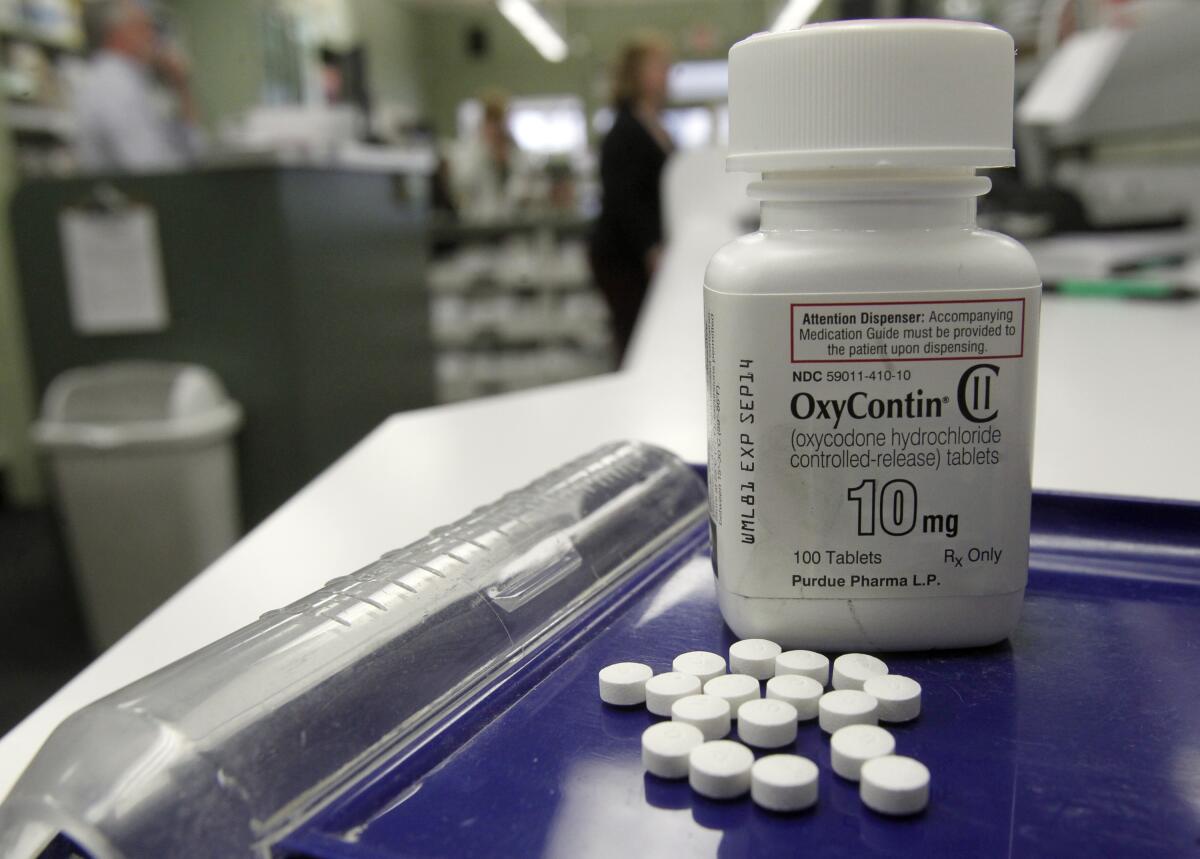Op-Ed: Finally, some promising news on opioids for patients in severe pain

- Share via
The U.S. remains in the midst of an ever-worsening drug overdose crisis. Because prescription opioids drove its earlier phases, the nation responded by drastically reducing access to those drugs — with prescriptions dropping by nearly 50% over the last decade. But it’s now clear that approach was ineffective at combating overdoses, and it left many patients with painful medical conditions stranded.
Overdose deaths have continued to soar even as fewer opioids have been prescribed. More dangerous drugs filled the gap: At least two-thirds of overdose deaths are now tied to synthetic opioids, mostly fentanyl, a powerful black market opioid. Meanwhile, physicians have had to balance the risk of criminal prosecution for prescribing opioids against their responsibility to treat patients’ pain.
Yet there is promising news amid our nation’s cycle of failed attempts to tackle the crisis. Two key shifts in federal policy this year hint that the pendulum is beginning to swing back toward more access to opioids for patients who need them.
My family knows the cost of failed ‘tough on crime’ policies. It’s time to try community strengthening instead.
The first is opioid prescribing guidelines that the Centers for Disease Control and Prevention updated last month. They undo a controversial feature of the agency’s 2016 guidance: the cap on opioids at 90 morphine milligram equivalents, or MME, per day. Although this number was never meant to serve as a hard line, law enforcement, regulators and healthcare providers widely interpreted it as one. The problem is that some patients need more than that amount. The validity of using any MME metric has also come under fire. Recent studies show that there is no universal standard for calculating appropriate MME, and methods to determine cutoffs vary widely; a patient who is considered “high risk” for overdose or addiction when evaluated using one method could be “undertreated” according to another.
But these arbitrary standards changed the landscape. Following the 2016 guidelines, insurance companies began to deny payment for pain management above 90 MME. Physicians faced a climate of mounting fear: Although U.S. law allows physicians to prescribe opioid medications for “legitimate medical purposes,” that definition grew more contentious. Law enforcement agencies, including the Drug Enforcement Administration, cited the 90 MME limit in investigations. While some doctors were financially incentivized to overprescribe opioids, others caught scrutiny simply for providing relief to patients in debilitating pain.
After taking higher doses for years, many patients were rapidly tapered under the limit, no matter how painful their health condition was. Some were cut off entirely, unable to find a doctor still willing to prescribe for their chronic pain.
Since then, extensive research has shown that some healthcare providers were inappropriately reducing opioid prescriptions even for cancer, palliative and end-of-life patients, who were supposed to be exempt from limits. Tragically, recent studies found that chronic pain patients who are rapidly tapered off opioids have high rates of suicide and overdose, as people turn to desperate measures for pain relief, including seeking illicit street opioids.
In a step forward for treatment, this year’s CDC guidelines avoid emphasizing specific thresholds. Recognizing the harms of excessive tapering and limits, they instead discuss ranges of dosages appropriate for different conditions and highlight the need for doctors to use their clinical judgment for each patient.
The second major shift on opioids this year was the June Supreme Court ruling in Ruan vs. United States making it more difficult for law enforcement agencies to prosecute doctors for prescribing painkillers. The decision raises the bar for criminal convictions, requiring that prosecutors prove that physicians knowingly or intentionally prescribed opioids inappropriately, not just that their practices deviated from government-defined standards. This will help give doctors more legal cover to treat pain as they see fit.
A drug taken by 26 million Americans is in short supply, setting up a public health crisis if patients turn to readily available alternatives like methamphetamine.
These shifts are early signs that the tides are beginning to turn back toward more access to opioids for patients who need them. But achieving that access will not be easy.
Physician willingness to prescribe opioids is a cultural phenomenon. Doctors have reduced their level of opioid prescribing not just from fear of prosecution but also based on trends in the field. Seminars, institutional guidelines and professional organization statements over the last decade have instilled the idea that prescribing opioids is something to be avoided.
Prescription opioids also remain an enemy in the public consciousness. Although the drugs have been overtaken by black market fentanyl in the overdose crisis, lawsuits against opioid manufacturers continue to command a disproportionate amount of big-swing prosecutorial attention. Of course, companies that deceptively promoted opioids in unsafe ways should be held accountable. But lawsuits against them do nothing to address the current fentanyl crisis, and they may give the false impression that prescription opioids still dominate the overdose problem.
Changing these narratives will take time. Similarly, it is not automatic that the Drug Enforcement Administration, other law enforcement, state governments or billing and insurance companies will change their protocols in line with the new CDC prescription guidance.
Tangible improvements for pain patients probably will happen over years, rather than days or months. They will also require attention to deep disparities in pain care and treatment access. My colleagues and I found in a 2019 study that opioid prescription rates in California varied by 300% based on neighborhood income and racial composition (with predominantly white neighborhoods being most likely to receive opioids and other controlled substances). This reminds us that medical guidelines are not neutral and need an intentional focus on equity to be implemented fairly.
Nonetheless, advocates, physicians and researchers working toward the goal of adequate pain treatment have cause for optimism. The question now is how readily doctors, insurance companies and law enforcement will respect the wisdom of current scientific evidence and legal standards.
Joseph Friedman is a substance use researcher at UCLA who studies the overdose crisis. @JosephRFriedman
More to Read
A cure for the common opinion
Get thought-provoking perspectives with our weekly newsletter.
You may occasionally receive promotional content from the Los Angeles Times.












